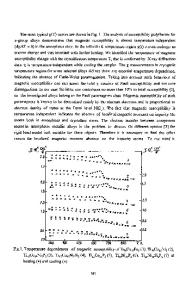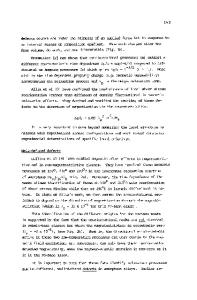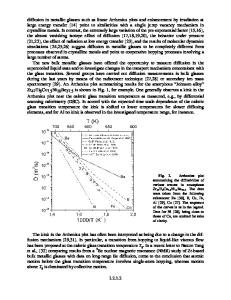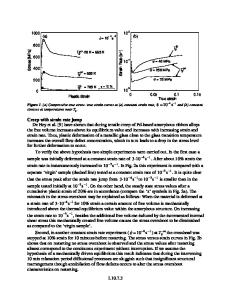Relaxation Processes in Two- and Three-Component Metallic Glasses
As long as the stability of amorphous structure occurs to be a very important property it is necessary to study the relaxation phenomena, i.e. the process of crystallization as a function of time. One of the methods to obtain the amorphous phase one-way i
- PDF / 20,201,207 Bytes
- 732 Pages / 439.37 x 666.142 pts Page_size
- 29 Downloads / 297 Views
Springer-Verlag Berlin Heidelberg GmbH
W. Haase · S. Wróbel (Eds.)
Relaxation Phenomena Liquid Crystals, Magnetic Systems, Polymers, High-Tc Superconductors, Metallic Glasses
With 412 Figures and 30 Tables
1 3
Professor Dr. Wolfgang Haase Darmstadt University of Technology Institute of Physical Chemistry Petersenstr. 20 64287 Darmstadt, Germany Email: [email protected] Professor Dr. Stanislaw Wróbel Jagellonian University Krakow Institute for Physics ul. Reymonta 4 30-049 Krakow, Poland Email: [email protected] or [email protected]
ISBN 978-3-642-07924-5 Library of Congress Cataloging-in-Publication Data Relaxation phenomena : liquid crystals, magnetic systems, polymers, high-Tc superconductors, metallic glasses / W. Haase, S. Wróbel (eds.). p. cm. Includes bibliographical references and index.
1. Relaxation phenomena. I. Haase, W. (Wolfgang) II. Wróbel, S. (Stanislaw) QC173.4.R44R47 2003 530.4’16--dc21 ISBN 978-3-642-07924-5 ISBN 978-3-662-09747-2 (eBook)
2003050473
DOI 10.1007/978-3-662-09747-2 This work is subject to copyright. All rights are reserved, whether the whole or part of the material is concerned, specifically the rights of translation, reprinting, reuse of illustrations, recitation, broadcasting, reproduction on microfilm or in any other way, and storage in data banks. Duplication of this publication or parts thereof is permitted only under the provisions of the German Copyright Law of September 9, 1965, in its current version, and permission for use must always be obtained from Springer-Verlag Berlin Heidelberg GmbH . Violations are liable for prosecution under the German Copyright Law.
© Springer-Verlag Berlin Heidelberg Originally published by Springer-Verlag Berlin Heidelberg New York in 2003 The use of designations, trademarks, etc. in this publication does not imply, even in the absence of a specific statement, that such names are exempt from the relevant protective laws and regulations and therefore free for general use. Cover Design: design & production, Heidelberg Typesetting: Springer-Verlag and LE-TEX GbR, Leipzig using a Springer LATEX macro packege Printed on acid-free paper 52/3141/YL 5 4 3 2 1 0
My contributions are dedicated to the memory of my beloved daughter Berit; she deceased unexpectedly on October 12, 2000, soon after closing our workshop in Zakopane, October 8−11, 2000. Wolfgang Haase
Preface
During the last three decades many new as well as extended classes of organic and inorganic materials, some of which being of hybrid type, have been synthe sized. Among them are those the contributors of this book are dealing with. In parallel to this, new technologies have been developed such as active matrix addressed liquid crystal displays (TFT-LCD), new types of sensors like ther mographic sheets employed in science, industry and medicine, organic light emitting diodes (OLEDs), SQUIDs etc. At the same time the techniques for characterizing both the materials and technological products have become very fast and highly precise. For example, today m
Data Loading...











